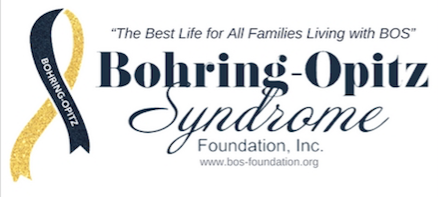Information below provided by the Registry Recruitment Document
How it works
Patients and families (including angels) with BOS or mutations in ASXL genes are enrolled in our study which is approved by the hospital ethics committees. Parents complete simple questionnaires online about their child’s medical history and may submit photographs as well as test results and notes from their physicians. The information is kept on a secure server. Identified information can only be accessed by the researchers in charge of the study. Deidentified content may be available to other researchers, members of the registry advisory board, and the study participants.
Please contact the email below with questions and to enroll in this study:
Why it matters
Rare diseases are just that; rare! It is hard for physicians to know how to best take care of patients when little is known about the disease including treatment and expected clinical outcomes. But by joining together, families can share their experiences and knowledge by being involved in clinical registries. Your participation helps patients with BOS and ASXL mutations get better care by collecting important information that the medical community needs. A well run registry also helps produce scientific literature and leads to new research findings.
Please email ASXL-CHROMATIN-REGISTRY@mednet.ucla.edu if you would like to enroll in the Registry
More information on Bohring-Opitz Syndrome can be found on the ARRE Foundation website.
PUBLICATIONS
A parent with a new BOS diagnosis, or a family member trying to learn more about the disorder can be overwhelmed by the medical literature about BOS. The literature is written in medical jargon and may be hard to understand. We polled our medical advisors for their top selections on the best articles for those new to the syndrome. Here’s what they suggested:
e best articles for those new to the syndrome. Here’s what they suggested:
RUSSELL B, TAN WH, GRAHAM JM JR. BOHRING-OPITZ SYNDROME. 2018 FEB 15. IN: ADAM MP, ARDINGER HH, PAGON RA, ET AL., EDITORS. GENEREVIEWS® [INTERNET]. SEATTLE (WA): UNIVERSITY OF WASHINGTON, SEATTLE; 1993-2018.
Read the article here:
https://www.ncbi.nlm.nih.gov/books/NBK481833/
Russell B, Johnston JJ, Biesecker LG, Kramer N, Pickart A, Rhead W, Tan W-H, Brownstein CA, Kate Clarkson L, Dobson A, Rosenberg AZ, Vergano SAS, Helm BM, Harrison RE, Graham Jr. JM. 2015. Clinical management of patients with ASXL1 mutations and Bohring–Opitz syndrome, emphasizing the need for Wilms tumor surveillance. Am J Med Genet Part A 167A:2122–2131.
Read the article here:
http://onlinelibrary.wiley.com/doi/10.1002/ajmg.a.37131/abstract
Dangiolo SB, Wilson A, Jobanputra V, Anyane-Yeboa K. 2015. Bohring–Opitz syndrome (BOS) with a new ASXL1 pathogenic variant: Review of the most prevalent molecular and phenotypic features of the syndrome. Am J Med Genet Part A 167A:3161–3166.
Read the article here:
http://onlinelibrary.wiley.com/doi/10.1002/ajmg.a.37342/abstract
Hastings, Rob; Cobben, Jan-Maarten; Gillessen-Kaesbach, Gabriele; Goodship, Judith; Hove, Hanne; Kjaergaard, Susanne; Kemp, Helena; Kingston, Helen; Lunt, Peter; Mansour, Sahar; McGowan,Ruth; Metcalfe, Kay; Murdoch-Davis, Catherine; Ray,Mary; Rio,Marle`ne; Smithson, Sarah; Tolmie, John; Turnpenny, Peter; van Bon, Bregje; Wieczorek, Dagmar; Newbury-Ecob, Ruth. 2011. Bohring–Opitz (Oberklaid–Danks) syndrome: clinical study, review of the literature, and discussion of possible pathogenesis. European Journal of Human Genetics.
Read the article here:
http://www.nature.com/ejhg/journal/v19/n5/full/ejhg2010234a.html
For a comprehensive list of all literature about BOS, please visit:
https://bohring-opitz.org/bosasxl1/resources/medical-publications/
